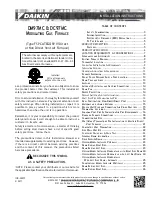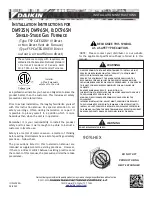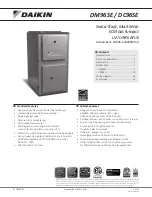
MAINTENANCE – CHIMNEY
For furnaces installed in houses, inspect flue pipes, flue pipe joints and
flue joint seals regularly to ensure that smoke and flue gases are not
drawn into and distributed by the air circulation system.
Chimney Inspection:
All chimney components should be checked for tight connections with all securing screws in place, no
rust and no smoke leakage. If any of these conditions are present, they should be repaired or replaced.
Creosote:
When wood is burning slowly, it produces tar and other organic vapors which combine with expelled
moisture to form creosote. The creosote vapors condense in the relatively cool chimney flue of a slow
burning fire. As a result, creosote residue accumulates on the flue lining. If ignited, this creosote creates
an extremely hot fire which may ignite surrounding materials resulting in a building fire.
Creosote can appear as:
A sooty powder
A gummy mess
A hard glaze
A deposit that resembles burned marshmallows
Note: The burning of unseasoned “green” wood greatly increases the buildup of creosote.
WinterGreen does not recommend the burning of green wood.
Cleaning the Chimney:
The chimney connector and chimney should be inspected at twice a month during the heating season to
determine if a creosote buildup has occurred.
Be aware that the hotter the fire, the less creosote is
deposited and that weekly cleanings may be necessary in mild weather, even though monthly
cleanings may be enough in the coldest months. WinterGreen recommends daily checks for
creosote buildup until experience shows how often cleaning is necessary. If creosote has accu-
mulated it should be removed to reduce the risk of a chimney fire.
Chimney inspection can be done by removing the inspection/cleanout cap at the base of the chimney
and viewing the flue condition or by checking the chimney from the top using a strong flashlight. Creo-
sote can be removed by using a chimney brush which is specific to the chimney size. Read and follow
the manufacturer’s instructions on proper use. Chimney brushes can be obtained at most local hardware
retailers or chimney stores.
THE HEAT EXCHANGER (BOILER TUBES), FLUE PIPE AND CHIM-
NEY MUST BE CLEANED REGULARLY TO REMOVE ACCUMU-
LATED CREOSOTE AND ASH. ENSURE THAT THE HEAT
EXCHANGER (BOILER TUBES), FLUE PIPE AND CHIMNEY ARE
CLEANED AT THE END OF THE HEATING SEASON TO MINIMIZE
CORROSION DURING THE SUMMER MONTHS. THE APPLIANCE,
FLUE PIPE AND CHIMNEY MUST BE IN GOOD CONDITION.
THESE INSTRUCTIONS ALSO APPLY TO THE DRAFT INDUCER
AND BAROMETRIC DAMPER
.
Continued on next page…
Содержание IM-130
Страница 8: ...WARNINGS SAFETY SAFETY LABEL LOCATIONS...
Страница 16: ...FURNACE COMPONENT LIST...
Страница 35: ...WOOD SELECTION CHART The Weights and Measure Act states that a cord of wood is 4 ft x 8 ft x 4ft 128 cu ft...
Страница 54: ...PLUMBING INSTALLATION...
Страница 57: ...WIRING CONTROLS Control Panel Components Figure 2 Control Panel FUSE...
Страница 65: ...TROUBLESHOOTING GUIDE...




































